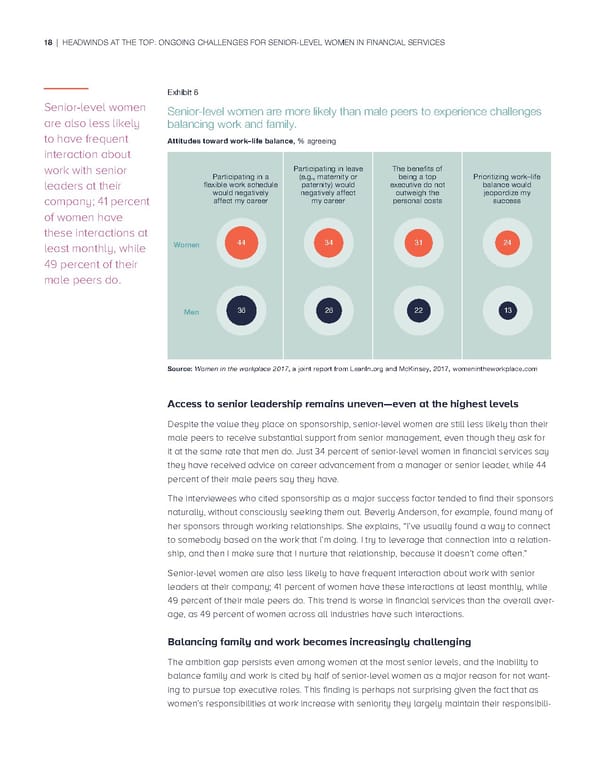18 | HEADWINDS AT THE TOP: ONGOING CHALLENGES FOR SENIOR-LEVEL WOMEN IN FINANCIAL SERVICES Exhibit 6 Senior-level women Senior-level women are more likely than male peers to experience challenges are also less likely balancing work and family. to have frequent Attitudes toward work–life balance, % agreeing interaction about work with senior Participating in leave The benefits of Participating in a (e.g., maternity or being a top Prioritizing work–life leaders at their flexible work schedule paternity) would executive do not balance would would negatively negatively affect outweigh the jeopordize my company; 41 percent affect my career my career personal costs success of women have these interactions at least monthly, while Women 44 34 31 24 49 percent of their male peers do. Men 36 26 22 13 Source: Women in the workplace 2017, a joint report from LeanIn.org and McKinsey, 2017, womenintheworkplace.com Access to senior leadership remains uneven—even at the highest levels Despite the value they place on sponsorship, senior-level women are still less likely than their male peers to receive substantial support from senior management, even though they ask for it at the same rate that men do. Just 34 percent of senior-level women in financial services say they have received advice on career advancement from a manager or senior leader, while 44 percent of their male peers say they have. The interviewees who cited sponsorship as a major success factor tended to find their sponsors naturally, without consciously seeking them out. Beverly Anderson, for example, found many of her sponsors through working relationships. She explains, “I’ve usually found a way to connect to somebody based on the work that I’m doing. I try to leverage that connection into a relation- ship, and then I make sure that I nurture that relationship, because it doesn’t come often.” Senior-level women are also less likely to have frequent interaction about work with senior leaders at their company; 41 percent of women have these interactions at least monthly, while 49 percent of their male peers do. This trend is worse in financial services than the overall aver- age, as 49 percent of women across all industries have such interactions. Balancing family and work becomes increasingly challenging The ambition gap persists even among women at the most senior levels, and the inability to balance family and work is cited by half of senior-level women as a major reason for not want- ing to pursue top executive roles. This finding is perhaps not surprising given the fact that as women’s responsibilities at work increase with seniority they largely maintain their responsibili-
 Closing the Gap Page 19 Page 21
Closing the Gap Page 19 Page 21